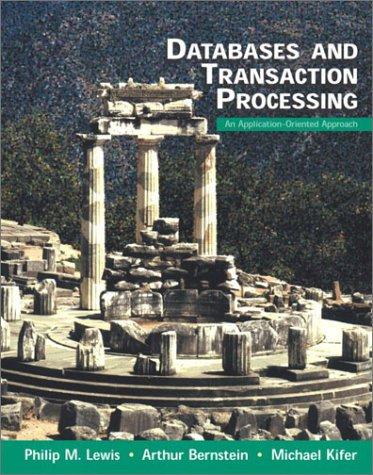Question
I need to create a simple Pseudocode for this prompt. Option 1: Authentication System For security-minded professionals, it is important that only the appropriate people
I need to create a simple Pseudocode for this prompt.
Option 1: Authentication System For security-minded professionals, it is important that only the appropriate people gain access to data in a computer system. This is called authentication. Once users gain entry, it is also important that they only see data related to their role in a computer system. This is called authorization. For the zoo, you will develop an authentication system that manages both authentication and authorization. You have been given a credentials file that contains credential information for authorized users. You have also been given three files, one for each role: zookeeper, veterinarian, and admin. Each role file describes the data the particular role should be authorized to access. Create an authentication system that does all of the following: Asks the user for a username Asks the user for a password Converts the password using a message digest five (MD5) hash o It is not required that you write the MD5 from scratch. Use the code located in this document and follow the comments in it to perform this operation. Checks the credentials against the valid credentials provided in the credentialsfile o Use the hashed passwordsin the second column; the third column contains the actual passwords for testing and the fourth row contains the role of each user. Limits failed attempts to three before notifying the user and exiting theprogram Gives authenticated users access to the correct role file after successfulauthentication o The system information stored in the role file should be displayed. For example, if a zookeepers credentials is successfully authenticated, then the contents from the zookeeper file will be displayed. If an admins credentials is successfully authenticated, then the contents from the admin file will be displayed. Allows a user to log out Stays on the credential screen until either a successful attempt has been made, three unsuccessful attempts have been made, or a user chooses to exit You are allowed to add extra roles if you would like to see another type of user added to the system, but you may not remove any of the existing roles.
For the prompt I am to use this Pseudocode guide:
Pseudocode is an intermediary step between reading a problem statement and writing the code to solve the problem. It serves as a blueprint for your program to guide you through, just like contractors start with a blueprint before building a house. Use your pseudocode as a tool to begin thinking about your program, but keep in mind it might not be the final solution to the problem. Pseudocode is written in a natural language using some programming keywords. Consider the first example below: INCREMENT the number of apples in the basket by one Notice in the example that it fully describes, in natural language, what needs to be done in the program. When writing pseudocode, start at the beginning of what you need the program to do. Then work through, step by step, until reaching the end of whats required by the program in the problem statement. This is putting the problem in sequence. For example, making a peanut butter sandwich: OBTAIN a plate OBTAIN two slices of bread OBTAIN a jar of peanut butter OBTAIN a knife Place the slices of bread on the plate Open the jar of peanut butter Spread peanut butter on one bread slice with the knife Place the empty slice of bread on top of the slice with peanut butter Serve There are several common keywords that get capitalized as they refer to actions taken in the program. Those words include READ, WRITE, PRINT, DISPLAY, CALCULATE, SET, INCREMENT, and more. You can also show choices and loops in pseudocode. Just like in coding, when an item is nested inside another item, you indent that line of pseudocode. Below are three generic examples: IF condition THEN Include the first sequence ELSE Include the second sequence ENDIF WHILE condition Include the sequence ENDWHILE FOR loop parameters Include the sequence ENDFOR You can also use the keyword CALL to reference another algorithm written separately. Now look at the following more complete examples of both good and bad pseudocode to get a general feel of how to write it
Step by Step Solution
There are 3 Steps involved in it
Step: 1

Get Instant Access to Expert-Tailored Solutions
See step-by-step solutions with expert insights and AI powered tools for academic success
Step: 2

Step: 3

Ace Your Homework with AI
Get the answers you need in no time with our AI-driven, step-by-step assistance
Get Started


